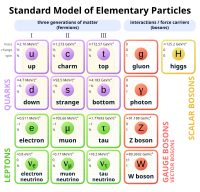
Photo from wikipedia
We have investigated phenomenological aspects of kaon photoproduction in three different extreme kinematics. The first kinematics of interest is the threshold region. At the threshold we have investigated the convergence… Click to show full abstract
We have investigated phenomenological aspects of kaon photoproduction in three different extreme kinematics. The first kinematics of interest is the threshold region. At the threshold we have investigated the convergence of kaon photoproduction amplitude by expanding the square of the amplitude in terms of the ratio $m_K/m$, where $m_K$ is the mass of kaon and $m$ is the averaged mass of nucleon and $\Lambda$-hyperon. The amplitude is calculated from the appropriate Feynman diagrams by using the pseudovector theory. The contact diagram as a consequence of the PCAC hypothesis is also taken into account in the amplitude. Our finding indicates that the convergence can be only achieved if the amplitude was expanded up to at least $12^{\rm th}$ order. As a consequence, applications of some theoretical calculations based on the expansion the scattering amplitude, such as the Low Energy Theorem or Soft Kaon Approximation, cannot be easily managed in kaon photoproduction. The second kinematics is the forward region, where we could assume only $t$-channel contributes to the process. Here we have investigated the effect of amplitude expansion on the extraction of the coupling constants $g_{K^+\Lambda p}$ and $g^V_{K_1^+\Lambda p}$. The last kinematics is the backward region, where we have also assumed that only $u$-channel survives and we could extract the leading coupling constants $g_{K^+\Lambda p} $ and $g_{K^+\Sigma^0 p}$.
Journal Title: Acta Physica Polonica B
Year Published: 2019
Link to full text (if available)
Share on Social Media: Sign Up to like & get
recommendations!